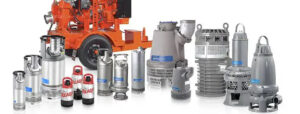Damage caused by clogging can cause a pump’s mechanism to slow down and lead to pump tripping or worse. Xylem’s research has found the true cause of clogging.
Big or small?
Clogging in wastewater systems is a common problem for engineers. Objects in wastewater reach the impeller – the rotating mechanism moving the liquid – which then causes a jam, trip or even a motor burnout. There is still the misconception that clogging is caused by big objects in the wastewater stream and the focus is on preventing this from happening. Instead, the real culprits are not the big objects but the tiny ones: the synthetic fibres and threads.A rule of thumb since 1915
A century old rule of thumb is still used in the world of pumps to prevent clogging risks. This rule determines that a pump’s throughlet (the passage containing the impeller) must be equal to or larger than any object that could be flushed down the toilet. The rule is not redundant, it has resulted in designs for relatively good pump practices for a long time. However, research has shown that this rule is not always so accurate in the prevention of clogging situations. “The biggest issue with the throughlet rule is that it focuses on large and hard objects as the main culprits behind clogs and impeller damage,” says Chetan Mistry, Xylem Africa’s Strategy and Marketing Manager. “But a lot of research, including work by Xylem, shows that this idea is misdirected. Hard and heavy solids tend to settle in low-flow parts of pipe systems and rarely reach pumps. They are not the ultimate source of clogging problems.”Enlarging the throughlet size means the design of the impeller needs to change to be able to operate within the larger area and avoid damage by larger objects moving through. Examples of these designs are single-vane impellers and vortex impellers. However, they are not so efficient and hard on bearings.
Our biggest problem: synthetic fibres
Households use cleaning rags and wet wipes containing synthetic fibres such as nylon, polyester, rayon or vinyl. These are either flushed or the fibres land in the wastewater system through washing machines. “Synthetic fibres are a pump’s version of death by a thousand cuts,” Mistry explains. “Small bits of fibre snag onto the impeller. At first, there isn’t an obvious impact. But as the fibres collect on the impeller and its shaft, they start to slow it down and eventually create a tangle that damages the pump.”What is the solution?
A clever design emerged, where impellers with substantially backswept leading edges push solids to the periphery it is ejected into the pump discharge channel through a relief groove in the insert ring. Different types of solids contributing to clogs are actively removed by this self-cleaning system first pioneered in Flygt N- technology. These newer impeller designs are between 25 and 64 percent more efficient than alternatives such as vortex or single-vane impellers, depending on the environment. After testing this concept thoroughly, Xylem engineers published a white paper about the challenges behind clogging. “The global need for solutions to transport and clean water is constantly growing,” says Mats Karlén, the paper’s co-author. “Helping to find ways of doing this more effectively and with improved energy efficiency is both a massive challenge and extremely rewarding. It’s clear that the amount of energy required to transport water could be significantly reduced by delivering improved sustained efficiency and higher clog resistance.”








